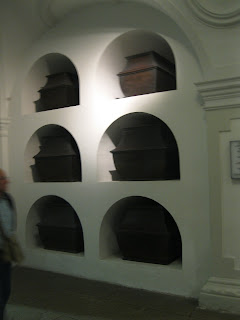17512 the day started out innocuously enough, Czech language class in the morning, we practiced more of the restaurant conversation bits, then went on to discuss the Austro-Hungarian empire. Harlow went into a little bit the history of Vienna, as we will be heading over there tomorrow. i do like talking about all the court intrigue, and empire-maneuvering the Hapsburgs did, so i was entertained. the classes were in the main building of the university, and it reminded me much of any other university building over 40 yrs old (so mostly not like northeastern). after which me and a few others got burgers, i had a "mexican" which had lettuce, tomatoes, a slice of cheese, home made ketchup, and "guacamole" the guacamole was the consistency of drinkable yogurt, and had hunks of cucumber in it. regardless, it was tasty, we went home, reconvened and headed to the KGB museum up the hill. HOLY SHIT. the museum was ok, a bunch of stuff that he "bought, changed (i think he meant traded) and stole, filled this rather small space. the guy that runs it is russian, spends half his time in "the City of Lenin" (Leningrad {now known as St. Petersburg}) and the other half here in Prague, running this museum. so we walk in, he speaks russian, and poor english, and immediately hands me a PPS ( http://en.wikipedia.org/wiki/PPS-43 ). and puts a hat on my head, explaining that this machine gun was designed during "second war". he put a hat on my head, and then went to the wall and pulled a WWII era CZ pistol, and some kinda Makarov to one of my party, a WWI era Nagant revolver to hand to someone else, and then a German MP-40 to the last of us, and takes pictures... all the while explaining briefly what each of the guns was now, i am comfortable with guns, but im not about to accept a firearm from some strange dude operating a tiny KGB museum in Prague, without checking it. i started racking the slide to ensure it was clear, it didnt budge, the safety didnt move, the mag release did nothing and while i have never handled one before, it seemed to be oddly balanced, i still never attempted to pull the trigger. i eventually got my hands on all of the guns, and all of them were misbalanced, with slides that didnt move, they were rendered thoroughly inoperable.


he showed us around and pointed out stuff, "this was the camera used by the NKVD for spying, it was made by NKVD orphan children" "this was the uniform used by NKVD, they had read star, it was not until later that whole red army had red star" there was a womans sniper uniform, covered in what i thought was hay, apparently it was horses cut from the tails of german horses, so the german dogs, who were often trained by officers on horseback, wouldnt smell the snipers out.

pokin around, they had some cool stuff, the guy seemed very knowledgable and very interested in what he was doing. it wasnt until later that myself and Alex (a history major) start to notice he is a little off. he briefly talked about how Trotsky was an American agent, working for US banks... the next section was talking about gulags, how the NKVD was used by Stalin to liquidate the rich Kulaks that refused to give up their land. he explains that Gulag is an acronym for Гла́вное управле́ние исправи́тельно-трудовы́х лагере́й и коло́ний, Chief Administration of Corrective Labor Camps and Colonies. he insisted that they were labor camps, and not concentration camps, that "no one killed anyone there". he extolled the White Sea - Baltic Canal, how the soviet workers dug 140 miles of canals, by hand in 21 months. he also talked about how Khrushchev demonized Stalin, saying that Stalin murdered millions of Soviet citizens, and our guide ardently claimed these were lies, that the great and beautiful Stalin would never do something like that. we meandered through more of the museum. and we decided it would be AWESOME to talk to this guy more, and we approached him as we were leaving, to see if we could get more out of him, he was very nervous, and blamed his reticence on his poor english, he ultimately accepted our email so he could send more info on the KGB and its incarnations, "not the defamation, lies, propaganda and slander like Алекса́ндр Иса́евич Солжени́цын. http://en.wikipedia.org/wiki/Aleksandr_Solzhenitsyn this was bananas. this guy genuinely believed in Stalinist Russia, at one point he mentioned how the higher ups ruined the Soviet Union, that Gorbachev and Kissinger worked together to unmake the country. I really really want to talk to him more, maybe we can get Harlow to come with and translate and ask questions. it was absolutely fascinating, i knew people still idolized Stalin, especially in the post-communist Russia, it was a shit hole, Russia became a superpower under Stalin, i get it but to claim subsequent historians are lairs and propagandists? thats PLANTAINS.

dunno whats goin on for the rest of the night, as i said, we are off to Vienna tomorrow, so i dunno how the internetz will be over there. if you dont hear from me, the internets shit, or the bus esploded or something.
























































